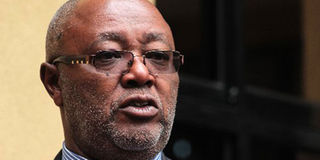Varsities and colleges placement agency starts receiving applications

Kenya Universities and Colleges Central Placement Service CEO John Muraguri. The agency has started receiving applications from last year’s Kenya Certificate of Secondary Education candidates through their schools and centres. PHOTO |FILE | NATION MEDIA GROUP
What you need to know:
- A total of 574,125 candidates sat their examination in 9,154 centres across the country.
- Universities asked to present their capacities by the end of next week to enable the board to know the number of students who will be placed in their respective institutions.
- Once the selection is concluded, students will be expected to report to their respective universities starting August.
The Kenya Universities and Colleges Central Placement Service (KUCCPS) has started receiving applications from last year’s Kenya Certificate of Secondary Education candidates through their schools and centres.
Schools are required to upload the details of the candidates in the KUCCPS system by Sunday.
A total of 574,125 candidates sat their examination in 9,154 centres across the country.
“Thereafter, an announcement on revision of degree and diploma course choices by the individual candidates will be made at an appropriate time through the media and the placement service website,” said the agency’s chief executive John Muraguri.
Mr Muraguri added that universities had also been asked to present their capacities by the end of next week to enable the board to know the number of students who will be placed in their respective institutions.
Once the selection is concluded, students will be expected to report to their respective universities starting August.
A total of 88,929 candidates who attained the minimum university entry qualification of C+ and above are set to get direct entry to universities against a capacity of about 96,000.
Last year, a total of 74,000 candidates joined public universities while 12,000 joined private universities under the government-sponsored programme, while another 12,000 joined colleges. This means that a total of 44,792 candidates who scored C plain have been shut out of degree programmes and will now study for diploma courses at tertiary institutions, joining another 61,026 who scored C- and 80,951 D+ to scramble for about 50,000 available slots in 57 tertiary institutions and 70 public and private universities.
LACK OF SPACE
Last year, 91, 378 of 165,766 students who scored the minimum university entry grade of C+ were locked out of university due to lack of space.
In 2016, Moi University admitted 5,825 students, followed by Kenyatta University at 5,598 and University of Nairobi at 5,374. Both public and private universities have the capacity to take in more than 160,000 students annually.
Statistic from CUE indicate that public universities are hosting 461,820 students which is 86percent while private universities are accommodating 77, 929 which is 14percent with the total enrolment was 539,749 as late 2016.
The government is set to implement a programme where university students get loans depending on their courses, commonly known as Differentiated Unit Cost (DUC).
The implementation of the programme starting July is expected address some of the shortcomings in funding.
Last year, universities proposed an increase in funding to students from the current Sh32 billion per year to Sh65 billion.
A report by Vice-chancellors led by Prof Francis Aduol indicate that it costs Sh600,000 to train a dentist, medicine costs Sh576,000, veterinary medicine Sh468,000, pharmacy Sh432,000 and a general art degree Sh144,000.
Under the current funding formula, the government provides about Sh86,000 to public universities for each student while Helb pays the institutions Sh8,000 and parents Sh26,000 as fees bringing the total to Sh120,000.
Besides this, Helb gives each student between Sh35,000 and Sh50,000 for books, food and accommodation annually. The Sh120,000 was based on 1995 calculations.





